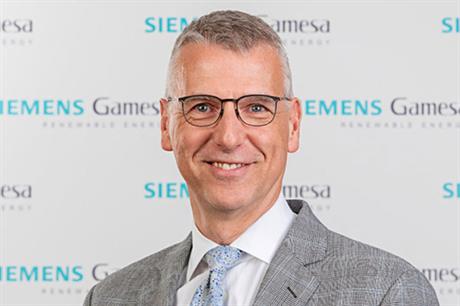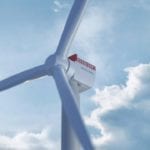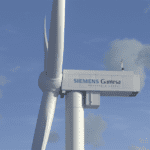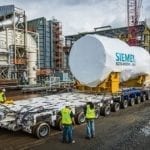Wind turbine maker Siemens Gamesa Renewable Energy (SGRE) has lowered its sales forecast for 2020, and the company said it expects the economic impact of COVID-19 will cut €1 billion ($1.2 billion) from its sales revenue in the full year.
The company in its latest earnings report, released July 30, said the impact of the coronavirus pandemic will be harsher than previously expected. SGRE reported a net loss of €466 million ($549 million) for the past three months, its fiscal third quarter, compared to a gain of €21 million in the same period last year. The company said the loss included “a –€93 million direct impact of COVID-19.”
SGRE said the fallout from the pandemic includes fewer sales of wind turbines in several markets, and delays in the construction of projects in northern Europe, partly due to supply chain disruptions.
The company said sales in the full year ending Sept. 30 will be between €9.5 billion and €10 billion. The company lowered its sales forecast after reporting sales fell 8.4% in April through June from the same period in 2019.
“This represents a reduction of €1 billion in revenues and of between €200 and €250 million in profitability compared to the previous guidance,” the company said.
Orders Down 44%
SGRE said its orders fell 44% in April to June compared with the same period last year, owing largely to COVID-19, an economic slowdown in India, and project uncertainty in Mexico. Nordex, a German competitor, earlier this month reported a 56% decline in second-quarter orders, but said it expected demand to come back strongly in the second half.
Andreas Nauen, overseeing the first earnings report since he took over as SGRE’s chief executive in June, replacing Marcus Tacke, said, “We are navigating a complicated period, as an industry and as a company, and the numbers we have presented today reflect that. Nevertheless, we are already taking measures to turn the onshore business around and return to profitability. The long-term outlook for our business is promising and our company has the technology and people needed to play a major role in developing a recovery underpinned by clean energies that help combat the effects of climate change.”

Nauen last week in a pre-earnings meeting said some of the company’s financial problems are of its own making, in addition to the external forces. “We have no illusions about the difficult circumstances we find ourselves in and we are fully focused on turning the ship around,” he said. Nauen said he expects the next quarter will see a return to operating income, but said that would not ensure against a loss in the full year.
There were some bright spots in Thursday’s report. SGRE said its order intake rose 14% year-over-year in the quarter to €5.3 billion. The company said it signed offshore wind deals totaling 2,860 MW of generation capacity, up 87% compared to the same period in 2019.
Turnaround Efforts
The company has said it already has taken some turnaround steps, including a change of course in India to tailor the group’s business there to actual market demand. The company Thursday said it is working to optimize its global industrial footprint, and implementing an acceleration program in an effort to assure profitability for the three business units. That program, called LEAP, “will be unveiled at the Capital Markets Day, scheduled for 27 August,” the company said.
Thursday’s report showed the company’s usual gauge of earnings before interest and tax, which also excludes the impact of other items including certain restructuring and amortization costs, was negative by €161 million. The operating margin on those earnings relative to income was a negative 6.7%.
SGRE and other wind turbine manufacturers have said the pandemic has exacerbated conditions that have altered the sector’s economics this year. Manufacturers have cited a move by several governments away from generous fixed tariffs and toward competitive auctions.
Operating margins have been squeezed by the rising cost of steel, in part due to a trade war between the U.S. and China. Manufacturing also has been slowed as factories were temporarily shut down.
—Darrell Proctor is associate editor for POWER (@DarrellProctor1, @POWERmagazine).










